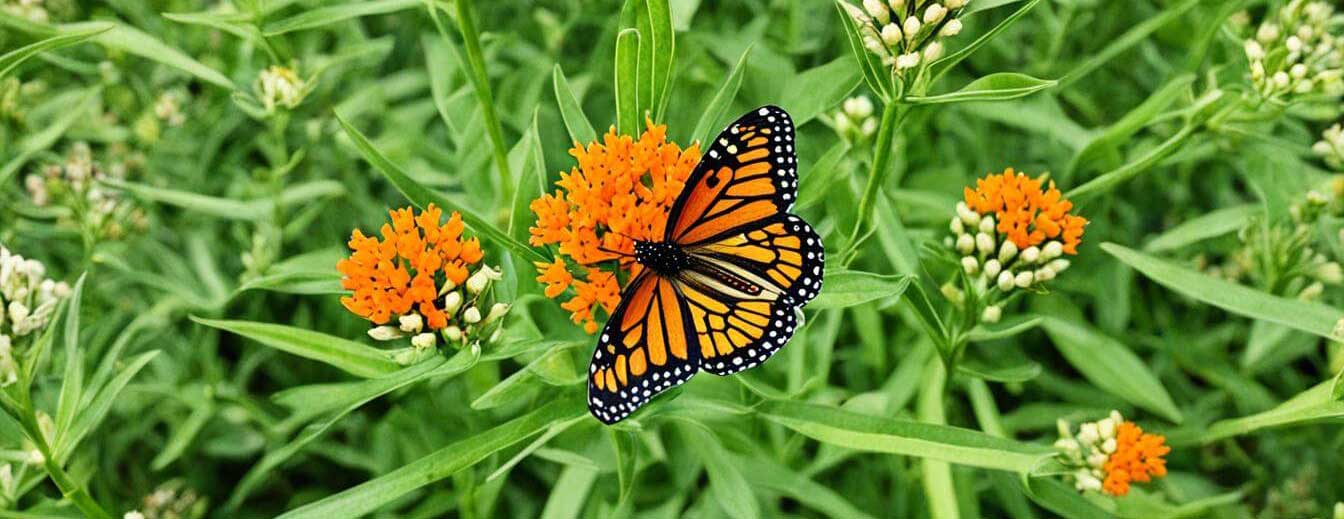Butterfly Weed | Asclepias tuberosa
Sustainable Landscaping with Native Plants
“Chances are, you have never thought of your garden, indeed of all of the space on your property, as a wildlife preserve that represents the last opportunity we have for sustaining plants and animals that were once common throughout the U.S.”
Butterfly weed is a milkweed plant that attracts butterflies to the garden with its clusters of bright orange-to-yellow blooms rich with nectar and pollen. This clump-forming perennial grows two feet tall from tuberous roots with glossy green, lance-shaped leaves. It requires at least eight hours of full sun and well-draining soil. It handles high humidity and arid climates equally well, provided it gets adequate soil moisture. A stunningly showy wildflower with a long bloom period , butterfly weed is native to most of the United States. Asclepias tuberosa is one of the best nectar plants for a wide variety of pollinators.
Milkweed is essential for the monarch butterfly’s life cycle. Without milkweed, the larvae would not be able to develop into butterflies. Milkweed contains a a variety of chemical compounds that make monarch caterpillars poisonous to potential predators. The Viceroy butterfly takes advantage of the protective coloration of the monarch butterfly by “mimicking”, or copying the colors and pattern of the monarch wing. With similar coloration, the viceroy can be mistaken for a monarch and is safe from these “educated” predators..
Types of Butterfly Weed
There are several named cultivars of this plant. Most varieties, as well as the native species, are orange. But some popular varieties offer color variations:
- Hello Yellow is a variety with bright yellow flowers.
- Gay Butterflies has decidedly reddish flowers.
- Western Gold Mix has golden-orange flowers and is bred primarily for the alkaline soils of the western United States.
Light
Choose a spot in your garden that boasts bright sunlight daily, as this plant loves to soak up the rays. Full sun is your best bet.
Water
During its first year of life (or until new plants start showing mature growth), you should maintain a moist soil environment for butterfly weed, giving it about one inch of water per week through combined rainfall and irrigation. Once the plant appears well-established, you can cut back to watering it only occasionally, as it prefers dry soil. An extensive, deep taproot helps it thrive even in dry conditions. Mature plants can do well with just monthly watering in all but the driest climates.
Soil
Butterfly weed can prosper in various soil conditions and compositions, from sand to gravel, and it generally prefers a neutral to slightly acidic pH.
Fertilizer
Butterfly weed is a low-maintenance plant that does not require any additional fertilization. Doing so can harm the plant, making it excessively leggy and reducing blooms. Additionally, butterfly weed plants should not be fertilized. While fertilizer may work to make other plants bloom, it can harm butterfly weed and discourage blooming. If the plant is not receiving adequate sunlight, it may not bloom; consider moving it to a new location.
Overwintering
Overwintering butterfly weed is a simple matter of cutting off the plant stem near ground level as soon as the plant succumbs to cold temperatures in the fall or early winter. There is no harm in leaving the plant stalks in place, though this encourages rampant self-seeding, which is usually not desired. Don’t mulch over the root crowns, as this can promote rot.
Companion Plants
Excellent companion plants for butterfly weeds include other plants that have similar care needs and will attract butterflies, such as perennials like liatris, allium, monarda, lavender, catmint, and rudbeckia. Some annual plant combinations include lantana, zinnia, salvia, cosmos, fennel, dill, and sunflowers.
At Lincoln Landscaping cultivating the environment is our life and livelihood. It is our number one goal to help our clients create and maintain beautiful landscapes while reducing the impact on the environment. Whether you are interested in a pollinator landscape garden design and build or other landscaping or property management project; we can create for you an environmentally friendly, organic and beautiful property.
Lincoln Landscaping “The Natural Choice”
Mike Kolenut President & CEO
https://lincolnlandscapinginc.com
(201) 848-9699











